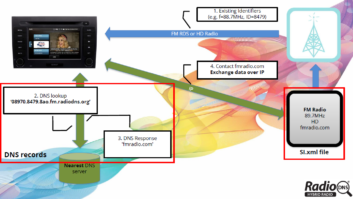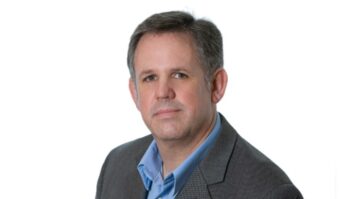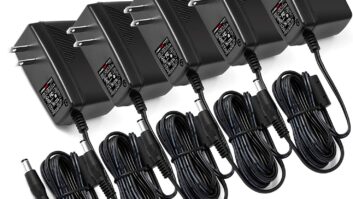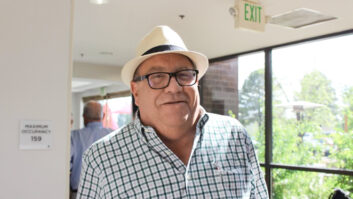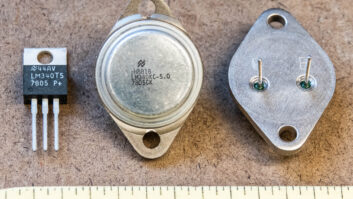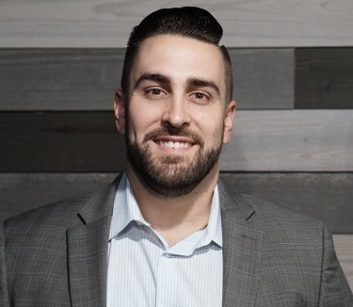 The recipient of the Radio World Excellence in Engineering Award for 2020–21 is Jason Ornellas, regional director of engineering for Bonneville International.
The recipient of the Radio World Excellence in Engineering Award for 2020–21 is Jason Ornellas, regional director of engineering for Bonneville International.
Recipients of the award represent the highest ideals of the radio broadcast engineering profession and reflect those ideals through contributions to the industry.
We selected Ornellas as the 17th recipient of this award because of his years of outstanding current and past work for four major broadcast companies; his project expertise, exemplified in recent large studio projects in California including one completed during early weeks of the pandemic; and for his role in streamlining and reimagining workflows at Bonneville.
We also salute the way Jason celebrates the successes of fellow engineers; for his work as part of the NAB Radio Technology Committee’s Next Gen Radio Architecture group and its PPM subgroup; and for his growing national profile including multiple terms on the board of the Society of Broadcast Engineers.
Jason Ornellas is 33, but he already has 15 years of solid engineering work and accomplishments to his credit. And we’re not the only ones who have noticed. Just this fall he was promoted to oversee Bonneville’s chief engineers and IT specialists in its West Coast markets of Seattle, San Francisco and Sacramento, a position in which he works more closely with senior leadership.
Quick learner
Born and raised in San Francisco, Ornellas was not looking for a radio technology career when he went to college. While attending the University of Indianapolis on a baseball scholarship, he took communication courses.
“One of the options was PR, radio, TV or journalism,” he told me. “And who doesn’t like music? So I ended up going for radio and got into it. [But] I realized really early on: I’m a terrible jock. I needed to not be on the air.”
He worked as a broadcast technician at the university’s FM station WICR, where he tinkered with IT, did remotes and maintenance, worked with audio consoles and automation, learned from the chief engineer and helped build his first AoIP studio.
“I really just got fascinated with signal flows and all of the under-the-hood stuff.”
He also had an internship with Clear Channel Radio in San Francisco during that time; and though it was a promotions internship rather than a technical one, it allowed him a foot in the door.
He stayed in touch with the staff in the Bay Area and told them of his interest; and at graduation time, when Clear Channel had an opening for a staff engineer there, Ornellas was ready.
During that two-year stint he managed 10 studios for the San Jose cluster and was responsible for the San Jose Sharks Radio Network.
He learned more about automation systems, facility and studio wiring, and networking. He gained experience with satellite feeds, on-call support, remote vans, webcasting, EAS and other meat-and-potatoes aspects of radio technology.
After two years, he was offered a job across the country as chief engineer of Greater Media’s New Jersey operations, including WDHA(FM) and WMTR(AM) and regional duties at several other stations.
“I’ve been very fortunate that the companies that I’ve worked for are all very well-respected and have always had great leadership from an engineering side,” he said.
He and his wife Ashley wanted to be back in California though, to be closer to family; so in 2014 they headed west again, and he became director of engineering for CBS Radio in Sacramento, overseeing technical aspects of a cluster of four FMs and one AM. During that time he also led the integration and worked on the design for the Jim Rome Studio in Costa Mesa, Calif.
Later, when Entercom merged with CBS Radio, four of the stations were sold to Bonneville — and Ornellas went along with them. He now reports to Scott Jones, Bonneville’s senior vice president for engineering and technology.
Along the way, people who have been particularly helpful in his career so far include Scott Uecker, general manager of WICR in Indianapolis and one of his college professors. “I owe him a lot for the opportunity, to have that kind of program at the University of Indianapolis that allowed this kind of hands-on experience.”
Also influential are David Williams at Clear Channel San Francisco (now iHeart); Milford Smith and Keith Smeal at Greater Media; and “all the legendary engineers at CBS, including Erik Disen and Sam Cappas … And here I am with Bonneville, and hopefully one day, I’m that mentor to someone else.”
Persistence
He’s had a super experience working for the company since he joined it.
“I’ve got a great team of engineers in all the markets. I love what I do. I’m a big believer in pushing the limits, trying to be innovative, and really thinking outside the box,” he said.
“I don’t like the answer, ‘It can’t be done.’ Well, let’s figure that out. Everything can be done. Someone has done something before, so let’s start peeling back the layers of what’s stopping it, and let’s move forward.”
To that end he has led two notable studio projects in the past two years.
The first came about when Entercom sold those Sacramento stations to Bonneville. As a result, studios and some operations of former CBS outlets KHTK(AM) and KNCI(FM) needed to move quickly to a location that was already serving KZZO(FM) and KYMX(FM).
“We left the facility in immaculate shape and successfully made the transition to all under one roof with zero downtime and under budget,” he recalls proudly.
Steve Cottingim, senior vice president and market manager for Bonneville Sacramento, told me, “When Bonneville began operating the Sacramento stations for the Entercom Trust, we had to move all of the stations to one building. Jason spearheaded the entire move and worked with Scott Jones to build out the studios and move all the equipment to get us back up and running with no interruption.
“Jason always rises to the occasion and delivers outstanding results. He is respected and loved by everyone in Sacramento. Jason is an individual who will go through walls to get things done. The engineering team that works with him all work together as a cohesive team because of his leadership.”
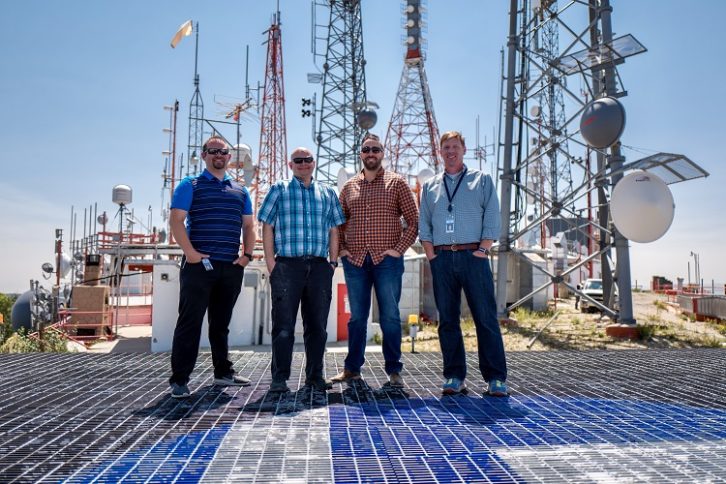
The second project was construction of a new studio location for Bonneville’s four FM stations in the Bay Area, KOIT, KMVQ, KBLX and KUFX .
Scott Jones said, “Jason was our project manager for our move out of San Francisco to our new, state-of-the-art facility in Daly City. Integrating a new AoIP plant built on the WheatNet architecture, our new studios are the crown jewel of Bonneville. His leadership kept us on schedule, even during the shelter-in-place orders in effect due to the global pandemic.”
That project came with another complication, a personal one. Jason and his wife Ashley have three kids under the age of 2; when their twin boys arrived in January this year, the babies needed to spend time in neonatal intensive care.
“The NICU, visiting them every day, as well as making sure San Francisco’s project stayed on task — it was definitely balancing life and work,” he recalled.
“But family’s first. My wife — bless her, because radio engineers’ wives don’t get enough credit. I’ve had to leave her at the table when I’m taking calls on a vacation. But she understands the role of the job. And I love being a dad.”
Consistency
So what’s ahead?
Part of his job is to implement standards that Bonneville wants to roll out for its air chains, systems and workflows. Seeking consistency across its markets, the company is standardizing on important components like Wheatstone AoIP networks, consoles and routing; RCS Zetta Automation; Telos VX studio phone systems; and Mitel Office phone systems.
“Our next big project is taking a step back, looking at our infrastructure. What is critical and high-risk that we need to get our eyes on? We’ve got some older transmitters that we need to get up to par with the solid-state, as well as finishing our rollout of our automation system to markets that we haven’t finished yet. … We’ve got to make sure our transmitters, our tower sites are up to par with how nice our studios look. We also will be transitioning to standardizing our HD transport with GatesAir and the FMXi4g Importer/Exporter unit.”
He expresses excitement about Bonneville’s efforts at streamlining systems and workflows, and how the technology team supports one another — driving to help a colleague in another market, raising a hand to help out or logging into a GUI remotely to help with a problem.
Managing a remote workforce for a radio organization, he points out, multiplies the usual number of technical problems that must be investigated.
“What are their resources like at home, with their network? Is it their network having issues? Is it the VPN having issues? It’s very time-consuming. But with this regional engineering technical infrastructure, we now have engineering teams that [can say], ‘Hey, I can take this one; I’ll deal with this issue; I’ll work on this ticket. Hey, I’m on a transmitter site today.’
Embracing change
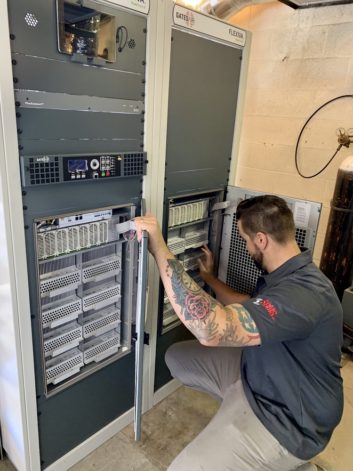
Beyond his immediate projects, I asked him about important trends in our industry. Ornellas describes himself as “all in” on the connected car.
“The more information, the more data, the more content that we can put in that dashboard,” he said, the better. He also has been a key part of Bonneville stations becoming active with the RadioDNS hybrid radio initiative.
Radio, he notes, remains the most popular source for people in their cars. “Now it’s up to broadcasters and manufacturers to make sure we don’t lose our place there. We have competition; there’s no doubt about it. But we still have that connection that will be hard to beat, as long as we provide the content that our consumers and clients are looking for.”
Meanwhile, within broadcast companies, he expects functions will increasingly become “virtualized” and that more hardware will become obsolete.
He has first-hand experience with this. Ornellas is a member of the NAB Radio Technology Committee’s Next-Generation Radio Architecture working group, and he chairs the PPM subgroup that has been working with manufacturers to get Nielsen Audio PPM encoding built into on-air processors.
As part of that work, he participated in a beta test of PPM encoding inside an Orban AM audio processor; and the working group plans a similar effort for FM and streaming, he said. Perhaps someday processing can even move to the cloud.
In general, he said, “We’re eliminating hardware and we’re integrating more software, to the point where we’re going to have be taking care of a lot more software than hardware. And we can fix a lot more with software than fixing it with a hardware box. … It’s exciting to see.”
The pandemic seems to have accelerated a change in thinking around the industry.
“I think a lot of manufacturers hit that reset button, and it gave everyone that little jolt that we needed as an industry, to really start thinking of the cloud architecture, about WANcasting, using your automation systems to its full capabilities and beyond, not just scratching the surface.”
He’s eager to see how workflows change over three to five years. “Everything will have an IP [connection] by then — if not already, we’re very close to that — but just being able to do one click and let it do multiple steps in multiple markets for us.”
I asked if this trend means big facility jobs like the one he recently completed will be the last of their kind.
“I don’t think the San Francisco project is the last one. However, I do think that they will be designed a lot differently.” The pandemic forced the idea of “broadcasting from home” into the mainstream, and its lessons won’t be forgotten.
“Studios are still going to be studios. I do think the common areas, the performance studios, large break rooms,—those are where you’re going to start seeing square footage not needed. Does every AE and sales manager need an office? Maybe have four or five community desks, not a dedicated seat for everyone.
“There’s going to be a lot of questions. Until we get to the next build, I don’t know the answer. But the facilities aren’t going to get bigger; they’re continuing to get smaller.”
Service
One of the things that impresses about Jason is how active he is at the national level. He is already on his third term as a member of the board of the Society of Broadcast Engineers.
“SBE has done a great job with creating new programs within memberships to really educate and get people more resources to learn and grow, within a reasonable budget and membership cost,” he said.
“We’re trying to stay really relevant and get a younger core to embrace the SBE — and not forget the history of it as well.”
To that point, I reminded him that people have been asking where the next generation of engineers will come from for decades. At 33 years old he is, unfortunately, atypical — a relatively fresh face with potentially decades of career in front of him, a young man who radiates ardent enthusiasm for radio engineering and technology.
Is he, in fact, a unicorn?
“I think I’m definitely one of the few. But they are out there,” he replied. To encourage more, he hopes the industry will expand the way it defines radio engineering. “It’s not just radio. It’s audio. It’s streaming. It’s metadata. It’s IP packets. It’s algorithms of the processors and encoding,” he said.
“There’s so much more to it, and we probably do ourselves a disservice by just thinking of RF. The RF side has gotten a lot easier, with computer monitoring and remote controls and whatnot; the RF isn’t as daunting anymore, especially with solid-state transmitters and not having to worry about tubes and retuning the grid or the cavity.”
Ornellas is heavily involved in his company’s streaming and podcast systems. “Everything I touch has an IP on it. It doesn’t need to be physically touched anymore like in the old days.”
He feels the industry has hurt itself by pushing many engineers out instead of helping them grow into these areas. And he expects the need for this expertise will only grow, given the trend toward virtualization and software.
“We might have an influx of new type of broadcast engineers. They might be very IT-driven, yet understand the signal flow of radio — the microphone, the console to STL, to processor, to transmitter. Everything’s going to be a lot more simple. The job is getting easier because it’s become more streamlined and because of how companies are looking at doing things.”
Positive force
I should add that anyone who has seen Jason’s posts on social media knows that he’ll be the first to cheer on colleagues and to spread positive feelings.
His boss Scott Jones calls Jason Ornellas “a born leader, with a keen technical mind and an innovative approach to broadcasting. He’s a positive force with his encouragement and passion. I am very proud of his leadership in driving excellence for Bonneville.”
Radio World couldn’t agree more.
Jason reminds us that radio is supposed to be fun. “It’s something new every day. You might have a plan, but that plan might get derailed,” he said.
“I like that. I like the unknown. I like fixing things and repairing things, playing with new equipment, installing it, testing, doing the R&D. There’s just so much that falls into engineering that it’s never a dull moment.
“And I love what I do.”
Comment on this or any article. Email [email protected].
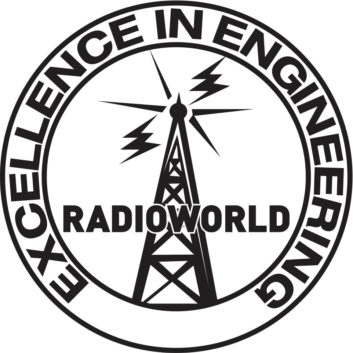 HONOR ROLL
HONOR ROLL
Recipients of the Radio World Excellence in Engineering Award represent the highest ideals of the U.S. radio broadcast engineering profession and reflect those ideals through contributions to the industry. (Read profiles of other recent recipients.)
2020-21 Jason Ornellas
2019-20 Dave Kolesar
2018-19 Russ Mundschenk
2017-18 Larry Wilkins
2016-17 Michael Cooney
2015 David H. Layer
2014 Wayne Pecena
2013 Marty Garrison
2012 Paul Brenner
2011 Barry Thomas
2010 Milford Smith
2009 Gary Kline
2008 Jeff Littlejohn
2007 Clay Freinwald
2006 John Lyons
2005 Mike Starling
2004 Andy Andreson





